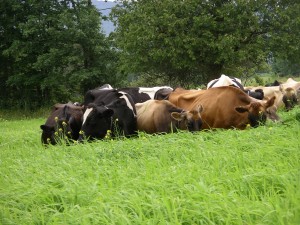Kimberly Hagen, Pasture Program
Originally published in the Center’s Cultivating Connections Newsletter, April 2015
Right-sizing: it’s what all farms must do if they are to stay profitable, and in balance, preserving the integrity of the soil, water and air, both on the farm and in the surrounding environment. As the water quality issue moves Vermont and its agricultural community into deeper levels of debate on how to address the issue, it’s clear that each farm must also work to find that “right size.”
Each farm has a unique set of variables due to its bedrock, soils, topography, water ( both underground and on the surface), type of livestock, vegetation and owner. It’s not unlike baking a cake. You lay out the ingredients, and then mix in proper proportion for taste, lightness and the fit to the pan it will be baked in. If the proportions are off, it won’t taste good, it may not rise, and it won’t fit in the pan, and overflow onto the oven floor makes for a tedious clean-up. That can happen with farms too.
Unfortunately, overflow from a farm is more than just tedious, it is costly: nutrients are lost and overloaded vegetation, soil and water sputter with the suffocation in a toxic brew or starve with overtaxing removal of nutrients needed for reproduction. The productivity potential is lost. Not only does the farm lose, but we all do as that toxicity taxes the farm’s soil and water and the local community’s collectively owned environment, lessening its productivity as well.
For example, if the wet areas or streams on your farm look like chocolate milk every time there is precipitation, nutrients are not being absorbed on the farm, and instead are making a quick exit. If you find you are feeding your animals stored feed by the beginning of July, you might want to think about reevaluating your land: livestock ratio, or at least your current management of them. These are signals of a need for better balance, and a change in management is often the simplest, and least expensive approach for getting started. Buffalo, cows and horses are heavy animals with 1000 pounds and more distributed on four feet. Confine them to a small area for weeks or months and it doesn’t take long before problems arise. Equally disruptive is frequent tillage and constant bare soil exposure. Moving air and water can hastily capture the freely floating nutrients, and carry them away, dropping them where they might not be needed or wanted – like a nearby lake or river..
Not long ago, I listened to a farmer describing the journey he had made after rejecting the conventional practices expected for a farming operation. He rejected that path because he was losing so much money, yet working harder than ever, and had no time with his family. His farm was not healthy and neither was he. Yet farming was his choice of profession. He decided to trust his own observations and judgement and after several years of trials seeking the match for the soils, the water, the vegetation, the livestock and the quality of life he wanted, he found the right size for his farm.
The familiarity was instant – this is a concept that I, like many of my colleagues, carry around in my mind. It’s succinct and descriptive. And it really is the core of what we do – working with farmers to find the right balance, that sweet spot of what the farm has for ingredients, its potential for productivity, and considering how best to manage those ingredients for the best possible outcome for meeting today’s needs. All while keeping a careful eye towards continued productivity into a sustainable future.
As one of UVM Extension’s technical service providers, I walk a careful path: listening to what farmers want, providing them with the information from research, yet also informing them of the parameters shaped by both the natural world and by humans. Our ultimate purpose is to help farmers find the farm practices and size that meet their own needs and goals, while maintaining balance with their community and natural resources.
This coming field season, we move into some new territory in the Connecticut River watershed (see pg. 7 of the Spring 2015 newsletter) . We look forward to working with farmers to find the right size for their operations – keeping the soil and water on their farms and in the river, clean, healthy and productive.

Recent Comments